Removal of Pharmaceutical Micropollutants with Integrated Biochar and Marine Microalgae
Abstract
:1. Introduction
2. Materials and Methods
2.1. Experimental Setup
2.2. Organic Micropollutant Measurements and Biochar Characteristic Monitoring
2.3. Optimisation Analysis
2.4. Effects of Pharmaceuticals and Personal Care Products on Microalgae
2.5. Adsorption Isotherm for Micropollutant Removal by Biochar
3. Results and Discussion
3.1. Removal of Pharmaceuticals and Personal Care Products
3.2. Effects of Pharmaceuticals and Personal Care Products Concentrations on Chaetoceros Muelleri
3.3. Adsorption Isotherm Study for the Removal of Pharmaceuticals and Personal Care Products by Biochar
4. Conclusions
- During running the first photobioreactor, the maximum abatement of CBZ, SMT and TRA was 90.5%, 93.5% and 88.7%, respectively, 35.4% (0.070 mg L−1), 33.1% (0.066 mg L−1) and 36.5% (0.146 mg L−1), respectively, on the contact time 8.5 to 10.50 days and the initial concentration of PPCPs of 0.20 to 0.40 mg L−1.
- The optimum removal of CBZ, SMT and TRA was 70.2% (0.421 mg L−1), 66.4% (0.398 mg L−1) and 70.1% (0.420 mg L−1) during running the second reactor, respectively, on the contact time 8.5 days and the initial concentration of PPCPs of 0.60 mg L−1.
- Based on the optimisation with RSM, the performance of the second reactor was much more than the first reactor. And maximum removal of CBZ (68.9%, 0.330 mg L−1), SMT (64.8%, 0.331 mg L−1) and TRA (69.3%, 0.332 mg L−1) was achieved at optimum contact time (8.1 d), and initial concentrations of MPs (0.48 mg L−1).
- By increasing the PPCPs concentration up to 40 mg L−1, protein and chlorophyll of marine diatom were increased. However, the protein, chlorophyll and cell viability were decreased by increasing the PPCP concentration from 40 mg L−1 to 100 mg L−1.
- The R2 values and MSE values were >0.99 and <0.90 during optimising removal of PPCPs with both reactors by ANN.
- Both Freundlich and Langmuir isotherms are proper for clarifying PPCPs adsorption by biochar.
Supplementary Materials
Author Contributions
Funding
Conflicts of Interest
References
- Xiao, L.; Liu, J.; Ge, J. Dynamic game in agriculture and industry cross-sectoral water pollution governance in developing countries. Agric. Water Manag. 2021, 243, 106417. [Google Scholar] [CrossRef]
- Azaroff, A.; Miossec, C.; Lanceleur, L.; Guyoneaud, R.; Monperrus, M. Priority and emerging micropollutants distribution from coastal to continental slope sediments: A case study of Capbreton Submarine Canyon (North Atlantic Ocean). Sci. Total Environ. 2020, 703, 135057. [Google Scholar] [CrossRef]
- Shao, Y.; Chen, Z.; Hollert, H.; Zhou, S.; Deutschamann, B.; Seiler, T.B. Toxicity of 10 organic micropollutants and their mixture: Implications for aquatic risk assessment. Sci. Total Environ. 2019, 666, 1273–1282. [Google Scholar] [CrossRef]
- Mojiri, A.; Kazeroon, R.A.; Gholami, A. Cross-Linked Magnetic Chitosan/Activated Biochar for Removal of Emerging Micropollutants from Water: Optimization by the Artificial Neural Network. Water 2019, 11, 551. [Google Scholar] [CrossRef] [Green Version]
- Vakili, A.; Mojiri, A.; Kindaichi, T.; Cagnetta, G.; Yuan, J.; Wang, B.; Giwa, A.S. Cross-linked chitosan/zeolite as a fixed-bed column for organic micropollutants removal from aqueous solution, optimization with RSM and artificial neural network. J. Environ. Manag. 2019, 250, 109434. [Google Scholar] [CrossRef] [PubMed]
- Kokkinos, P.; Mantzavinos, D.; Venieri, D. Current Trends in the Application of Nanomaterials for the Removal of Emerging Micropollutants and Pathogens from Water. Molecules 2020, 25, 2016. [Google Scholar] [CrossRef] [PubMed]
- Yentür, G.; Dükkancı, M. Synthesis of Visible-Light heterostructured photocatalyst of Ag/AgCl deposited on (0 4 0) facet of monoclinic BiVO4 for efficient carbamazepine photocatalytic removal. Appl. Surf. Sci. 2020, 531, 147322. [Google Scholar] [CrossRef]
- Li, N.; Liu, Q.; Zhou, G.Q.; Dai, M.X.; Kong, Q. Contaminant removal and microorganism response of activated sludge in sulfamethazine wastewater treatment. Int. Biodeterior. Biodegrad. 2019, 143, 104705. [Google Scholar] [CrossRef]
- Kolahi-Ahari, S.; Deiminiat, B.; Rounaghi, G.H. Modification of a pencil graphite electrode with multiwalled carbon nanotubes capped gold nanoparticles for electrochemical determination of tramadol. J. Electroanal. Chem. 2020, 862, 113996. [Google Scholar] [CrossRef]
- Kostanjevecki, P.; Petric, I.; Loncar, J.; Smital, T.; Ahel, M.; Terzic, S. Aerobic biodegradation of tramadol by pre-adapted activated sludge culture: Cometabolic transformations and bacterial community changes during enrichment. Sci. Total Environ. 2019, 687, 858–866. [Google Scholar] [CrossRef] [PubMed]
- Mojiri, A.; Vakili, M.; Farraji, H.; Aziz, S.Q. Combined ozone oxidation process and adsorption methods for the removal of acetaminophen and amoxicillin from aqueous solution; kinetic and optimisation. Environ. Technol. Innov. 2019, 15, 100404. [Google Scholar] [CrossRef]
- Shakerian, F.; Zhao, J.; Li, S.P. Recent development in the application of immobilized oxidative enzymes for bioremediation of hazardous micropollutants—A review. Chemosphere 2020, 239, 124716. [Google Scholar] [CrossRef] [PubMed]
- Myhead, E.; Silkina, A.; Llewellyn, C.A.; Fuentes-Grünewald, C. Comparing Nutrient Removal from Membrane Filtered and Unfiltered Domestic Wastewater Using Chlorella vulgaris. Biology 2020, 7, 12. [Google Scholar] [CrossRef] [PubMed] [Green Version]
- García-Galán, M.J.; Matamoros, V.; Uggetti, E.; Díez-Montero, R.; García, J. Removal and environmental risk assessment of contaminants of emerging concern from irrigation waters in a semi-closed microalgae photobioreactor. Environ. Res. 2020, 110278. [Google Scholar] [CrossRef] [PubMed]
- Robledo-Padilla, F.; Aquines, O.; Silva-Núñez, A.; Alemán-Nava, G.S.; Castillo-Zacarías, C.; Ramirez-Mendoza, R.A.; Zavala-Yoe, R.; Iqbal, H.M.N.; Parra-Saldívar, R. Evaluation and Predictive Modeling of Removal Condition for Bioadsorption of Indigo Blue Dye by Spirulina platensis. Microorganisms 2020, 8, 82. [Google Scholar] [CrossRef] [PubMed] [Green Version]
- Jiménez-Bambague, E.M.; Madera-Parra, C.A.; Ortiz-Escobar, A.C.; Morales-Acosta, P.A.; Peña-Salamanca, E.J.; Machuca-Martínez, F. High-rate algal pond for removal of pharmaceutical compounds from urban domestic wastewater under tropical conditions. Case study: Santiago de Cali, Colombia. Environ. Sci. Technol. 2020, 82, 1031–1043. [Google Scholar] [CrossRef]
- Minggat, E.; Roseil, W.; Tanaka, Y. Nutrient Absorption and Biomass Production by the Marine Diatom Chaetoceros muelleri: Effects of Temperature, Salinity, Photoperiod, and Light Intensity. J. Ecol. Eng. 2020, 22, 231–240. [Google Scholar] [CrossRef]
- Wang, X.W.; Liang, J.R.; Luo, C.S.; Chen, C.P.; Gao, Y.H. Biomass, total lipid production, and fatty acid composition of the marine diatom Chaetoceros muelleri in response to different CO2 levels. Bioresour. Technol. 2014, 161, 124–130. [Google Scholar] [CrossRef]
- Karthikeyan, P.; Manimaran, K.; Sampathkumar, P.; Rameshkumar, L. Growth and nutrient removal properties of the diatoms, Chaetoceros curvisetus and C. simplex under different nitrogen sources. Appl. Water Sci. 2013, 3, 49–55. [Google Scholar] [CrossRef] [Green Version]
- Mulla, S.I.; Bharagava, R.N.; Belhaj, D.; Ameen, F.; Saratale, G.D.; Gupta, S.K.; Tyagi, S.; Patil, K.S.; Hu, A. A Review of Micropollutant Removal by Microalgae. In Application of Microalgae in Wastewater Treatment, Volume 1: Domestic and Industrial Wastewater Treatment; Gupta, S.K., Bux, F., Eds.; Springer: Berlin/Heidelberg, Germany, 2019. [Google Scholar] [CrossRef]
- Xiang, W.; Zhang, X.; Chen, J.; Zou, W.; He, F.; Hu, X.; Tsang, D.C.W.; Ok, Y.S.; Gao, B. Biochar technology in wastewater treatment: A critical review. Chemosphere 2020, 252, 126539. [Google Scholar] [CrossRef]
- Pokharel, A.; Acharya, B.; Farooque, A. Biochar-Assisted Wastewater Treatment and Waste Valorization. In Applications of Biochar for Environmental Safety; Abdelhafez, A., Abbas, M., Eds.; IntechOpen: London, UK, 2020. [Google Scholar] [CrossRef]
- Gorovtsov, A.V.; Minkina, T.M.; Mandzhieva, S.S.; Perelomov, L.V.; Soja, G.; Zamulina, I.V.; Rajput, V.D.; Sushkova, S.N.; Mohan, D.; Yao, J. The mechanisms of biochar interactions with microorganisms in soil. Environ. Geochem. Health 2020, 42, 2495–2518. [Google Scholar] [CrossRef] [PubMed]
- Miazek, K.; Brozek-Pluska, B. Effect of PHRs and PCPs on Microalgal Growth, Metabolism and Microalgae-Based Bioremediation Processes: A Review. Int. J. Mol. Sci. 2019, 20, 2492. [Google Scholar] [CrossRef] [PubMed] [Green Version]
- Saygideger, S.D.; Okkay, O. Effect of 2,4-Dichlorophenoxyacetic acid on growth, protein and chlorophyll-a content of Chlorella vulgaris and Spirulina platensis cells. J. Environ. Biol. 2008, 29, 175–178. [Google Scholar] [PubMed]
- Zhang, W.; Zhang, M.; Lin, K.; Sun, W.; Xiong, B.; Guo, M.; Cui, X.; Fu, R. Eco-toxicological effect of Carbamazepine on Scenedesmus obliquus and Chlorella pyrenoidosa. Environ. Toxicol. Pharmacol. 2012, 33, 344–352. [Google Scholar] [CrossRef] [PubMed]
- Tsiaka, P.; Tsarpali, V.; Ntaikou, I.; Kostopoulou, M.N.; Lyberatos, G.; Dailianis, S. Carbamazepine-mediated pro-oxidant effects on the unicellular marine algal species Dunaliella tertiolecta and the hemocytes of mussel Mytilus galloprovincialis. Ecotoxicology 2013, 22, 1208–1220. [Google Scholar] [CrossRef] [PubMed]
- Mojiri, A.; Zhou, J.; Vakili, M.; Le, H.V. Removal performance and optimisation of pharmaceutical micropollutants from synthetic domestic wastewater by hybrid treatment. J. Contam. Hydrol. 2020, 235, 103736. [Google Scholar] [CrossRef]
- Schmidtová, Z.; Kodešová, R.; Grabicová, K.; Kočárek, M.; Fér, M.; Švecová, H.; Klement, A.; Nikodem, A.; Grabic, R. Competitive and synergic sorption of carbamazepine, citalopram, clindamycin, fexofenadine, irbesartan and sulfamethoxazole in seven soils. J. Contam. Hydrol. 2020, 234, 103680. [Google Scholar] [CrossRef]
- González-González, L.M.; Eltanahy, E.; Schenk, P.M. Assessing the fertilizing potential of microalgal digestates using the marine diatom Chaetoceros muelleri. Algal Res. 2019, 41, 101534. [Google Scholar] [CrossRef]
- Batista, I.; Garcia, A.B.; Dalen, P.V.; Kamermans, P.; Verdegem, M.; Smaal, A.C. Culturing Chaetoceros muelleri using simplified media with different N sources: Effects on production and lipid content. Eur. J. Phycol. 2015, 50, 92–99. [Google Scholar] [CrossRef]
- Sue, G.; Jiao, K.; Chang, J.; Li, Z.; Guo, X.; Sun, Y.; Zeng, X.; Lu, Y.; Lin, L. Enhancing total fatty acids and arachidonic acid production by the red microalgae Porphyridium purpureum. Bioresour. Bioprocess. 2016, 3, 33. [Google Scholar] [CrossRef] [Green Version]
- Dolatabadi, M.; Ahmadzadeh, S. A reapid and efficient removal of approach for degradation of metformin in pharmaceutical wastewater using elctro-Fenton process; optimisation by response surface methodology. Water Sci. Technol. 2019, 80, 685–694. [Google Scholar] [CrossRef] [PubMed]
- Dolatabadi, M.; Mehrabpour, M.; Esfandyari, M.; Ahmadzadeh, S. Adsorption of tetracycline antibiotic onto modified zeolite: Experimental investigation and modeling. MethodsX 2020, 7, 100886. [Google Scholar] [CrossRef] [PubMed]
- Chia, S.R.; Chew, K.W.; Zaid, H.F.M.; Chu, D.T.; Tao, Y.; Show, P.L. Microalgal Protein Extraction from Chlorella vulgaris FSP-E using Triphasic Partitioning Technique with Sonication. Front. Bioeng. Biotechnol. 2019, 7, 369. [Google Scholar] [CrossRef] [PubMed] [Green Version]
- Ma, M.; Liu, R.; Qu, J.; Jefferson, W. Effects and mechanisms of pre-chlorination on Microcystis aeruginosa removal by alum coagulation: Significance of the released intracellular organic matter. Sep. Purif. Technol. 2012, 19–25. [Google Scholar] [CrossRef]
- Namasivayam, S.K.R.; Jayakumar, D.; Kumar, V.R.; Bharani, R.S.A. Anti Bacterial and Anti Cancerous Biocompatible Silver Nanoparticles Synthesised from the Cold Tolerant Strain of Spirulina platensis. Res. J. Pharm. Technol. 2014, 7, 1404–1412. [Google Scholar] [CrossRef]
- Xiong, J.Q.; Kurade, M.B.; Abou-Shanab, R.A.I.; Ji, M.K.; Choi, J.; Kim, J.O.; Jeonh, B.H. Biodegradation of carbamazepine using freshwater microalgae Chlamydomonas mexicana and Scenedesmus obliquus and the determination of its metabolic fate. Bioresour. Technol. 2016, 205, 183–190. [Google Scholar] [CrossRef]
- Xiong, J.Q.; Kim, S.J.; Kurade, M.B.; Govindwar, S.; Abou-Shanab, R.A.I.; Kim, J.R.; Roh, H.S.; Khan, M.A.; Jeon, B.H. Combined effects of sulfamethazine and sulfamethoxazole on a freshwater microalga, Scenedesmus obliquus: Toxicity, biodegradation, and metabolic fate. J. Hazard. Mater. 2019, 370, 138–146. [Google Scholar] [CrossRef]
- Gojkovic, Z.; Lindberg, R.H.; Tysklind, M.; Funk, C. Northern green algae have the capacity to remove active pharmaceutical ingredients. Ecotoxicol. Environ. Saf. 2019, 170, 644–656. [Google Scholar] [CrossRef]
- Talboom, S.N.; Carrillo-Nieves, D.; Rostro-Alanis, M.J.; Crus Quiroz, R.; Barceló, D.; Iqbal, H.M.N.; Parra-Saldivar, R. Algal-based removal strategies for hazardous contaminants from the environment—A review. Sci. Total Environ. 2019, 665, 358–366. [Google Scholar] [CrossRef]
- Maryjoseph, S.; Ketheesan, B. Microalgae based wastewater treatment for the removal of emerging contaminants: A review of challenges and opportunities. Case Stud. Chem. Environ. Eng. 2020, 2, 100046. [Google Scholar] [CrossRef]
- Villar-Navarro, E.; Baena-Nogueras, R.M.; Paniw, M.; Perales, J.A.; Lara-Martín, P.A. Removal of pharmaceuticals in urban wastewater: High rate algae pond (HRAP) based technologies as an alternative to activated sludge based processes. Water Res. 2018, 139, 19–29. [Google Scholar] [CrossRef] [PubMed]
- Ndoun, M.C.; Elliot, H.A.; Presidendanz, H.E.; Williams, C.F.; Knopf, A.; Watson, J.E. Adsorption of pharmaceuticals from aqueous solutions using biochar derived from cotton gin waste and guayule bagasse. Biochar 2020, in press. [Google Scholar] [CrossRef]
- Magee, E.; Zhou, W.; Yang, H.; Zhang, D. The effect of biochar application in microalgal culture on the biomass yield and cellular lipids of chlorella vulgaris. In Proceedings of the Conference: Chemeca 2013: Challenging Tomorrow, Brisbane, Australia, 29 September–2 October 2013. [Google Scholar]
- Liao, N.; Li, Q.; Zhang, W.; Zhou, G.; Ma, L.; Min, W.; Ye, J.; Hou, Z. Effects of biochar on soil microbial community composition and activity in drip-irrigated desert soil. Eur. J. Soil Biol. 2016, 72, 27–34. [Google Scholar] [CrossRef]
- Zhu, X.; Chen, B.; Zhu, L.; Xing, B. Effects and mechanisms of biochar-microbe interactions in soil improvement and pollution remediation: A review. Environ. Pollut. 2017, 227, 98–115. [Google Scholar] [CrossRef]
- Khalid, A.A.H.; Yaakob, Z.; Abdullah, S.R.S.; Takriff, M.S. Analysis of the elemental composition and uptake mechanism of Chlorella sorokiniana for nutrient removal in agricultural wastewater under optimized response surface methodology (RSM) conditions. J. Clean. Prod. 2019, 210, 673–686. [Google Scholar] [CrossRef]
- Zhang, Y.; Guo, J.; Yao, T.; Zhang, Y.; Zhou, X.; Chu, H. The influence of four pharmaceuticals on Chlorellapyrenoidosa culture. Sci. Rep. 2019, 9, 1624. [Google Scholar] [CrossRef] [Green Version]
- Azevedo, F.C.R.; Vaz, I.C.D.; Barbosa, F.A.R. Toxicological effects of ciprofloxacin and chlorhexidine on growth and chlorophyll a synthesis of freshwater cyanobacteria. Braz. J. Pharm. Sci. 2019, 55, e17661. [Google Scholar] [CrossRef] [Green Version]
- Kim, E.; Jung, C.; Han, J.; Her, N.; Park, C.M.; Son, A.; Yoon, Y. Adsorption of selected micropollutants on powdered activated carbon and biochar in the presence of kaolinite. Desalin. Water Treat. 2016, 57, 27601–27613. [Google Scholar] [CrossRef]
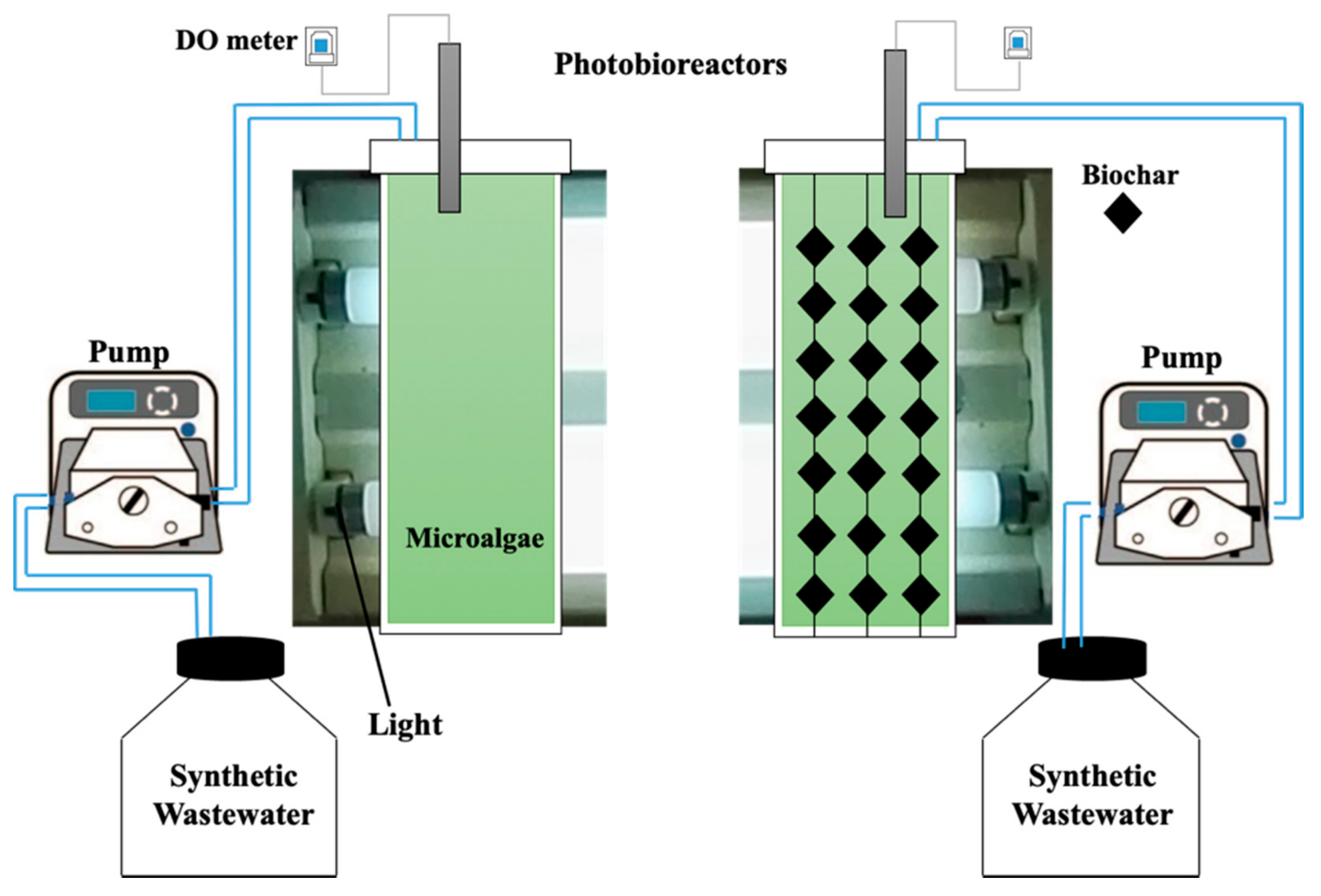
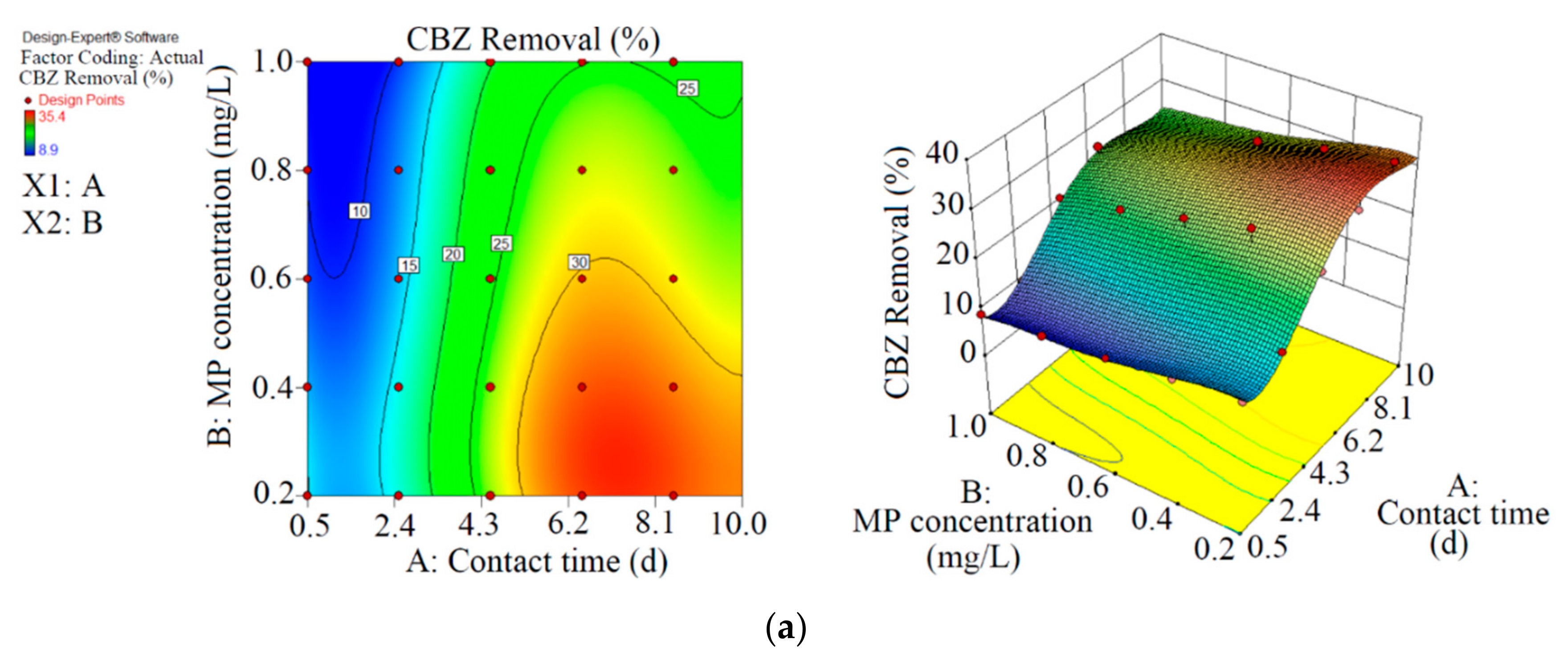
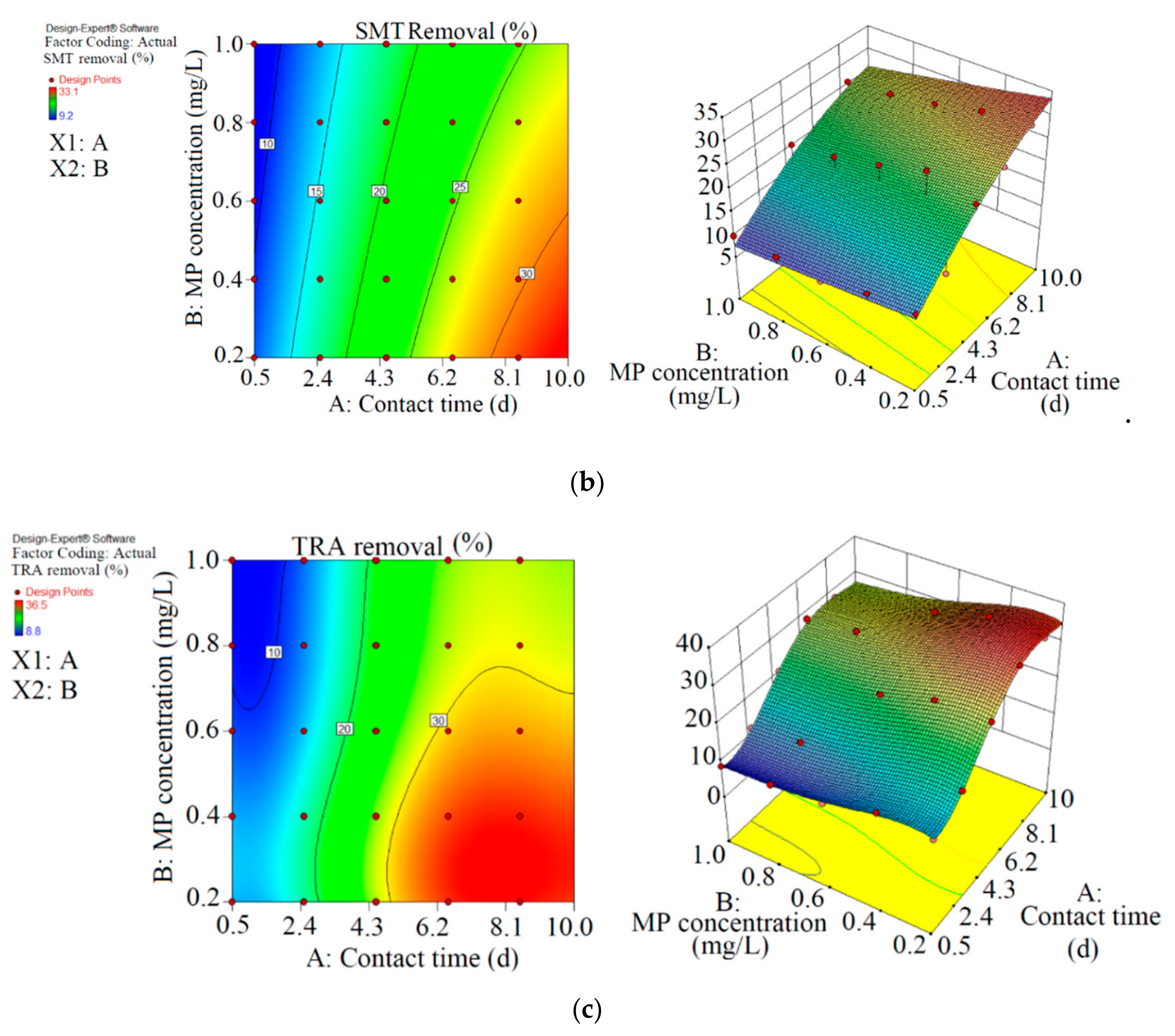

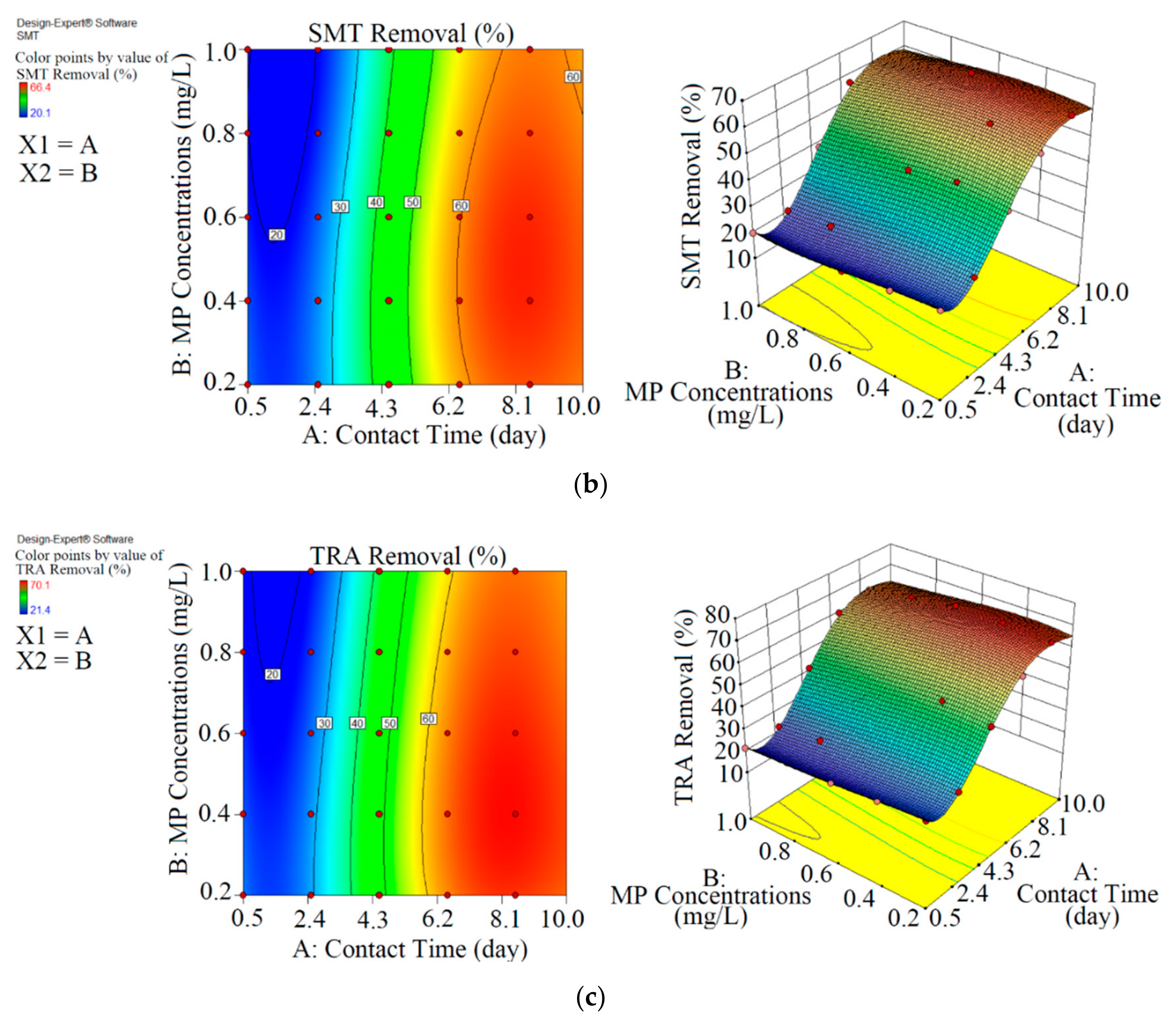
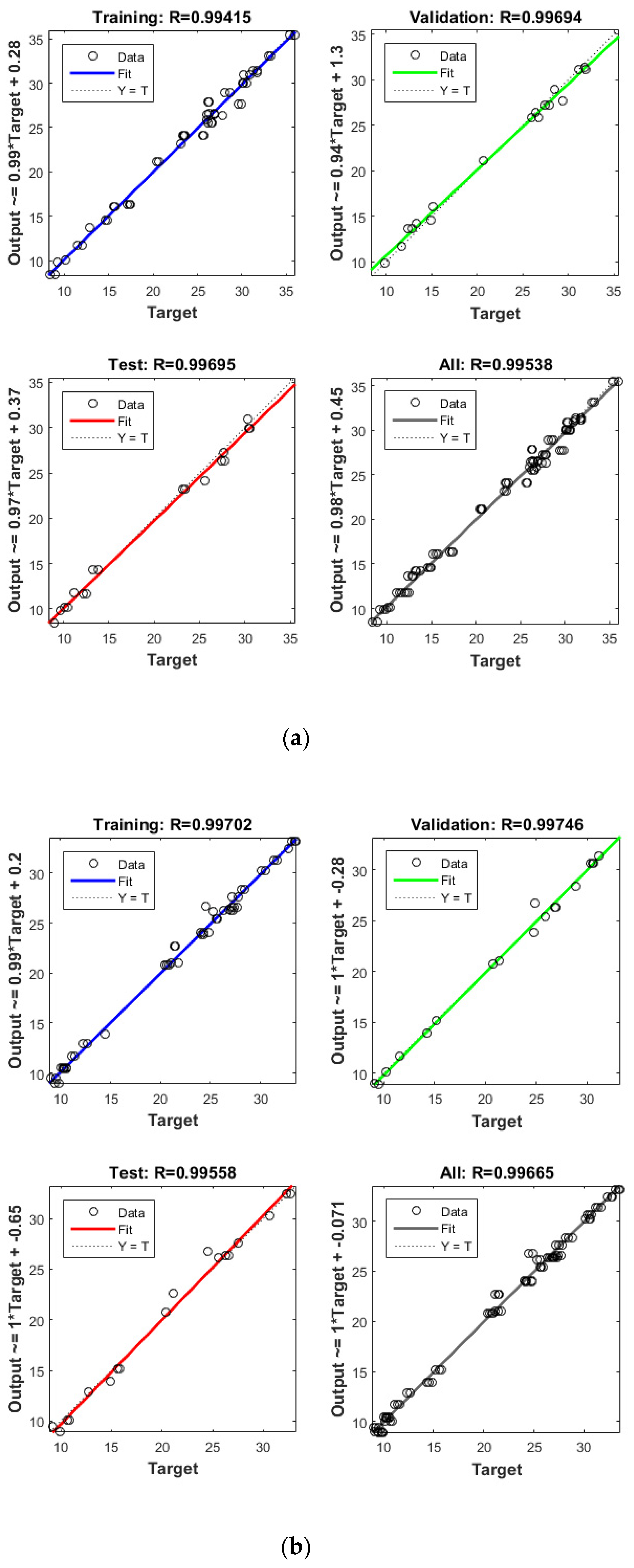
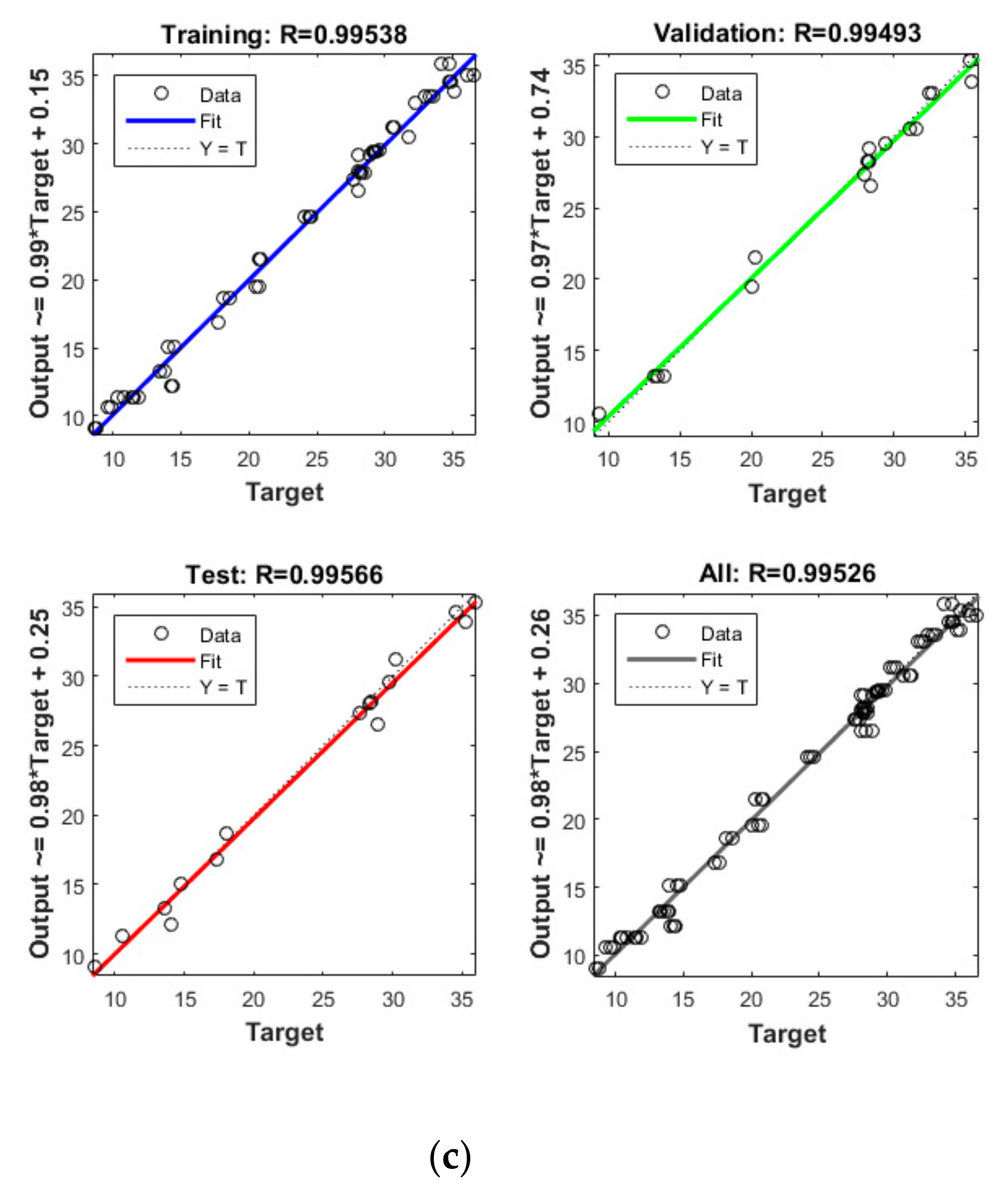
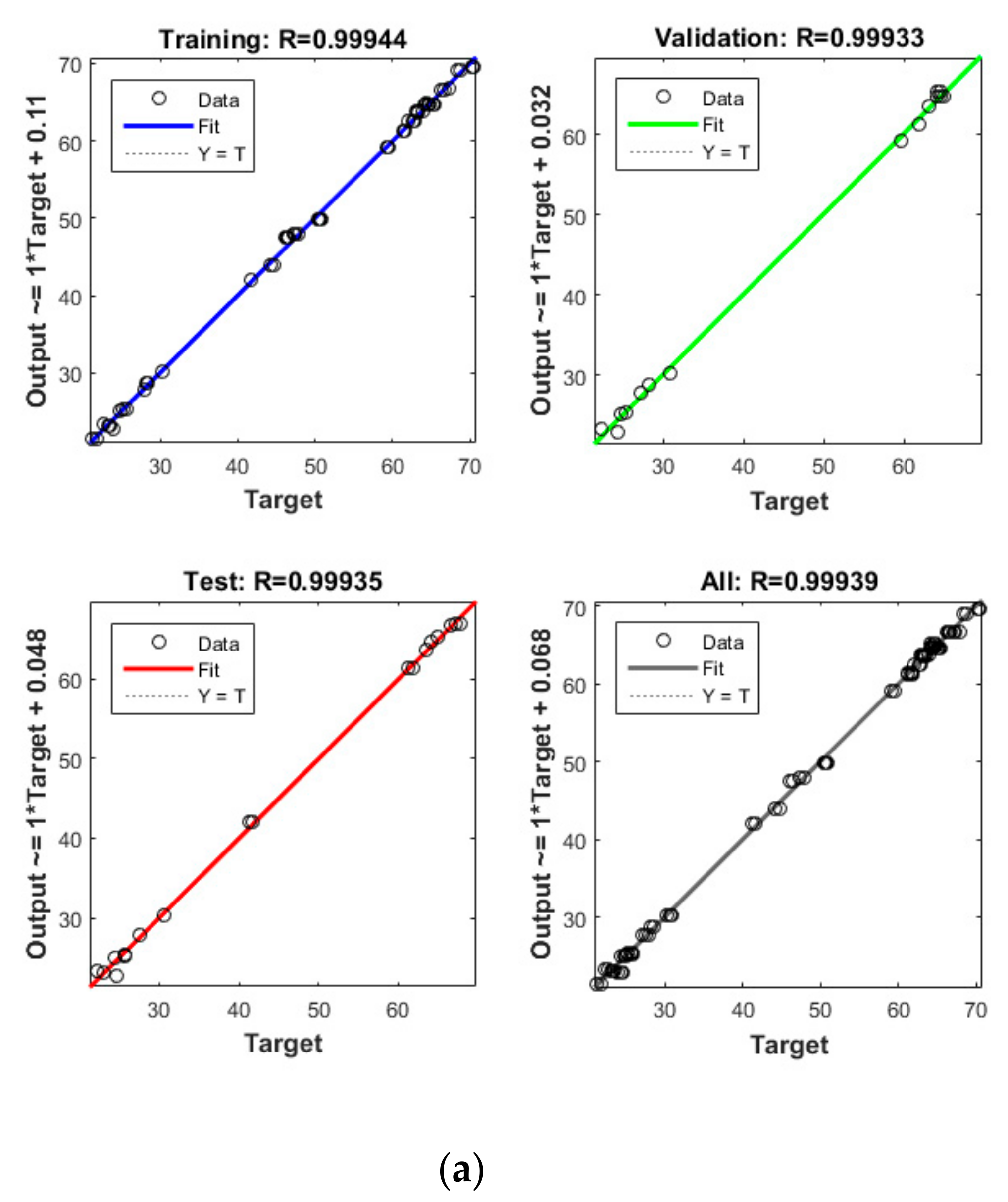

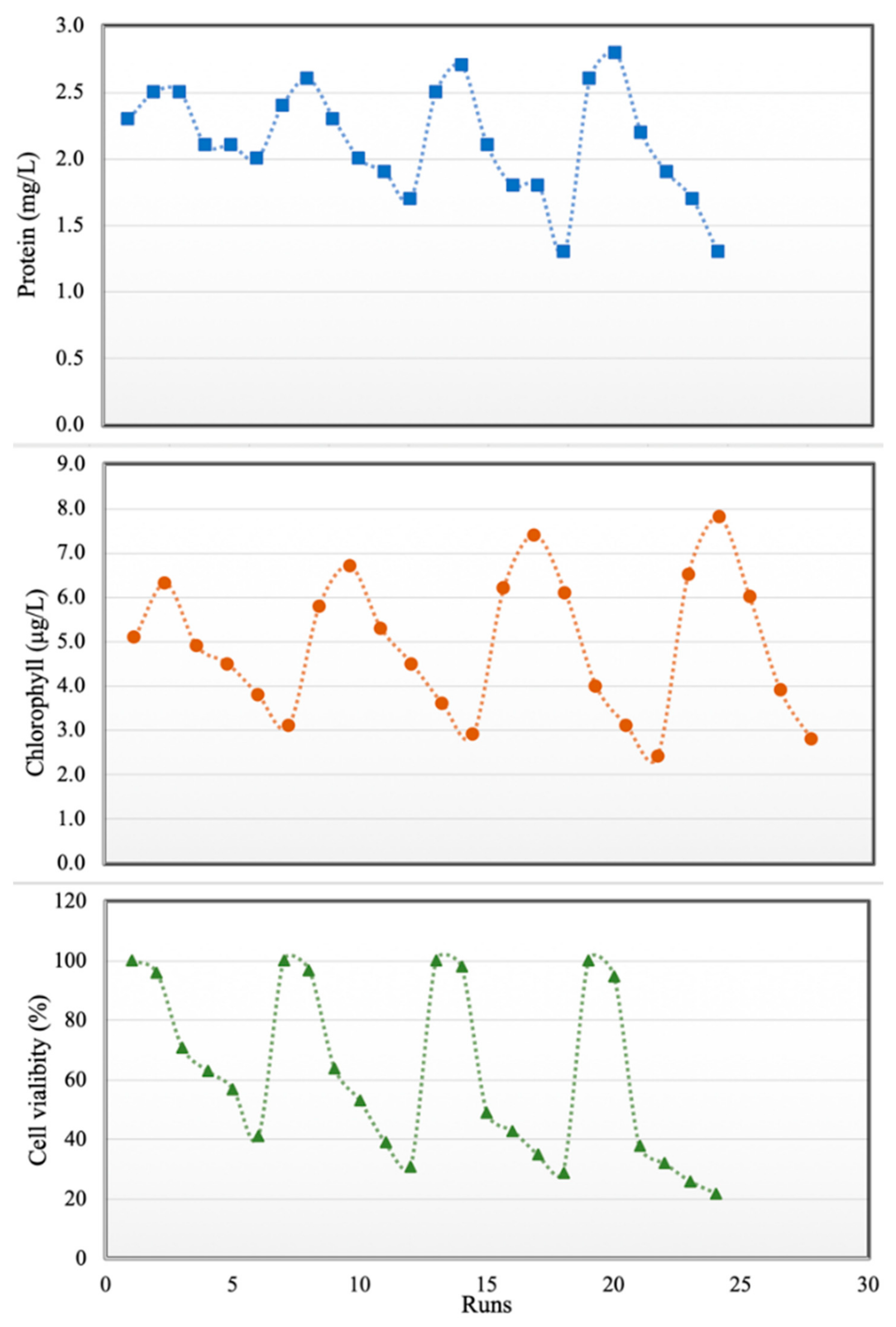
| Pharmaceuticals | Structure | CAS Number | Molecular Weight (mg) | References |
|---|---|---|---|---|
| Carbamazepine (CBZ) | C15H12N2O | 298-46-4 | 235.3 | [29] |
| Sulfamethoxazole (SMT) | C10H11N3O3S | 723-46-6 | 253.3 | [29] |
| Tramadol (TRA) | C16H25NO2 | 27203-92-5 | 263.37 | [9] |
| Run | Independent Factors | Average Removal of Organic Micropollutants | ||||||
|---|---|---|---|---|---|---|---|---|
| Contact Time (Day) | Initial Concentration (mg/L) | CBZ (%) | CBZ (mg L−1) | SMT (%) | SMT (mg L−1) | TRA (%) | TRA (mg L−1) | |
| 1 | 0.5 | 0.2 | 14.9 | 0.029 | 12.3 | 0.024 | 13.6 | 0.027 |
| 2 | 0.5 | 0.4 | 13.2 | 0.052 | 11.6 | 0.046 | 14.3 | 0.057 |
| 3 | 0.5 | 0.6 | 11.4 | 0.068 | 9.2 | 0.055 | 10.5 | 0.063 |
| 4 | 0.5 | 0.8 | 10.1 | 0.080 | 9.8 | 0.078 | 9.6 | 0.076 |
| 5 | 0.5 | 1.0 | 8.9 | 0.089 | 9.8 | 0.098 | 8.8 | 0.088 |
| 6 | 2.5 | 0.2 | 17.3 | 0.034 | 15.2 | 0.030 | 18.1 | 0.036 |
| 7 | 2.5 | 0.4 | 15.2 | 0.060 | 14.5 | 0.058 | 17.3 | 0.069 |
| 8 | 2.5 | 0.6 | 12.8 | 0.076 | 10.3 | 0.061 | 14.0 | 0.084 |
| 9 | 2.5 | 0.8 | 12.0 | 0.096 | 10.9 | 0.087 | 13.4 | 0.107 |
| 10 | 2.5 | 1.0 | 9.2 | 0.092 | 10.4 | 0.104 | 11.9 | 0.119 |
| 11 | 4.5 | 0.2 | 26.3 | 0.052 | 24.5 | 0.049 | 28.2 | 0.056 |
| 12 | 4.5 | 0.4 | 29.6 | 0.118 | 27.0 | 0.108 | 28.4 | 0.113 |
| 13 | 4.5 | 0.6 | 26.5 | 0.159 | 24.1 | 0.144 | 24.6 | 0.147 |
| 14 | 4.5 | 0.8 | 23.2 | 0.185 | 21.8 | 0.174 | 20.8 | 0.166 |
| 15 | 4.5 | 1.0 | 20.7 | 0.207 | 20.4 | 0.204 | 20.5 | 0.205 |
| 16 | 6.5 | 0.2 | 31.9 | 0.063 | 27.2 | 0.054 | 35.4 | 0.070 |
| 17 | 6.5 | 0.4 | 30.2 | 0.120 | 25.3 | 0.101 | 32.2 | 0.128 |
| 18 | 6.5 | 0.6 | 28.1 | 0.168 | 24.0 | 0.144 | 30.5 | 0.183 |
| 19 | 6.5 | 0.8 | 27.8 | 0.222 | 21.5 | 0.172 | 29.6 | 0.236 |
| 20 | 6.5 | 1.0 | 25.6 | 0.256 | 20.6 | 0.206 | 28.2 | 0.282 |
| 21 | 8.5 | 0.2 | 35.4 | 0.070 | 31.2 | 0.062 | 35.9 | 0.071 |
| 22 | 8.5 | 0.4 | 33.3 | 0.133 | 30.3 | 0.121 | 36.5 | 0.146 |
| 23 | 8.5 | 0.6 | 30.2 | 0.181 | 28.1 | 0.168 | 33.0 | 0.198 |
| 24 | 8.5 | 0.8 | 26.3 | 0.210 | 26.6 | 0.212 | 28.1 | 0.224 |
| 25 | 8.5 | 1.0 | 23.3 | 0.233 | 25.7 | 0.257 | 27.9 | 0.279 |
| 26 | 10.5 | 0.2 | 31.7 | 0.063 | 33.1 | 0.066 | 34.8 | 0.069 |
| 27 | 10.5 | 0.4 | 30.4 | 0.121 | 32.8 | 0.131 | 34.8 | 0.139 |
| 28 | 10.5 | 0.6 | 27.5 | 0.165 | 30.5 | 0.183 | 31.1 | 0.186 |
| 29 | 10.5 | 0.8 | 26.9 | 0.215 | 27.2 | 0.217 | 29.4 | 0.235 |
| 30 | 10.5 | 1.0 | 26.0 | 0.260 | 26.8 | 0.268 | 28.1 | 0.281 |
| Run | Independent Factors | Average Removal of Organic Micropollutants | ||||||
|---|---|---|---|---|---|---|---|---|
| Contact Time (Day) | Initial Concentration (mg/L) | CBZ (%) | CBZ (mg L−1) | SMT (%) | SMT (mg L−1) | TRA (%) | TRA (mg L−1) | |
| 1 | 0.5 | 0.2 | 27.9 | 0.055 | 24.9 | 0.049 | 27.3 | 0.054 |
| 2 | 0.5 | 0.4 | 25.2 | 0.100 | 23.3 | 0.093 | 25.6 | 0.102 |
| 3 | 0.5 | 0.6 | 24.4 | 0.146 | 21.9 | 0.131 | 24.0 | 0.144 |
| 4 | 0.5 | 0.8 | 23.1 | 0.184 | 21.5 | 0.172 | 23.9 | 0.191 |
| 5 | 0.5 | 1.0 | 21.9 | 0.219 | 20.1 | 0.201 | 21.4 | 0.214 |
| 6 | 2.5 | 0.2 | 30.3 | 0.060 | 27.9 | 0.055 | 29.5 | 0.059 |
| 7 | 2.5 | 0.4 | 28.2 | 0.112 | 26.6 | 0.106 | 28.0 | 0.112 |
| 8 | 2.5 | 0.6 | 25.8 | 0.154 | 22.9 | 0.137 | 25.6 | 0.153 |
| 9 | 2.5 | 0.8 | 24.0 | 0.192 | 22.5 | 0.180 | 24.5 | 0.196 |
| 10 | 2.5 | 1.0 | 22.2 | 0.222 | 20.8 | 0.208 | 22.4 | 0.224 |
| 11 | 4.5 | 0.2 | 47.3 | 0.094 | 43.9 | 0.087 | 48.6 | 0.097 |
| 12 | 4.5 | 0.4 | 50.6 | 0.202 | 46.8 | 0.187 | 51.3 | 0.205 |
| 13 | 4.5 | 0.6 | 46.5 | 0.279 | 43.9 | 0.263 | 46.8 | 0.280 |
| 14 | 4.5 | 0.8 | 44.2 | 0.353 | 40.3 | 0.322 | 44.1 | 0.352 |
| 15 | 4.5 | 1.0 | 41.7 | 0.417 | 38.5 | 0.385 | 41.8 | 0.418 |
| 16 | 6.5 | 0.2 | 61.9 | 0.123 | 56.9 | 0.113 | 61.8 | 0.123 |
| 17 | 6.5 | 0.4 | 64.2 | 0.256 | 60.8 | 0.243 | 64.3 | 0.257 |
| 18 | 6.5 | 0.6 | 64.1 | 0.384 | 59.5 | 0.357 | 63.0 | 0.378 |
| 19 | 6.5 | 0.8 | 61.8 | 0.494 | 57.0 | 0.456 | 61.1 | 0.488 |
| 20 | 6.5 | 1.0 | 59.6 | 0.596 | 56.9 | 0.569 | 60.0 | 0.600 |
| 21 | 8.5 | 0.2 | 67.4 | 0.134 | 63.6 | 0.127 | 68.2 | 0.136 |
| 22 | 8.5 | 0.4 | 68.3 | 0.273 | 64.3 | 0.257 | 69.4 | 0.277 |
| 23 | 8.5 | 0.6 | 70.2 | 0.421 | 66.4 | 0.398 | 70.1 | 0.420 |
| 24 | 8.5 | 0.8 | 66.3 | 0.530 | 61.9 | 0.495 | 66.9 | 0.535 |
| 25 | 8.5 | 1.0 | 63.3 | 0.633 | 59.5 | 0.595 | 63.7 | 0.637 |
| 26 | 10.5 | 0.2 | 64.7 | 0.129 | 60.8 | 0.121 | 65.0 | 0.130 |
| 27 | 10.5 | 0.4 | 64.4 | 0.257 | 59.9 | 0.239 | 64.6 | 0.258 |
| 28 | 10.5 | 0.6 | 65.5 | 0.393 | 60.8 | 0.364 | 65.1 | 0.390 |
| 29 | 10.5 | 0.8 | 63.9 | 0.511 | 59.8 | 0.478 | 62.7 | 0.501 |
| 30 | 10.5 | 1.0 | 62.0 | 0.620 | 58.2 | 0.582 | 61.9 | 0.619 |
| Reactor | Resp. | Optimization with RSM | Optimization with ANN | ||||||||
|---|---|---|---|---|---|---|---|---|---|---|---|
| R2* | Adj. R2 | Pred. R2 | SD | R2 | MSE | ||||||
| **Training | Valid. | Test | Training | Valid. | Test | ||||||
| Reactor-1 | CBZ | 0.976 | 0.954 | 0.915 | 1.73 | 0.996 | 0.996 | 0.994 | 0.664 | 0.535 | 0.532 |
| SMT | 0.928 | 0.913 | 0.897 | 2.33 | 0.997 | 0.997 | 0.995 | 0.370 | 0.333 | 0.653 | |
| TRA | 0.993 | 0.987 | 0.981 | 10.2 | 0.995 | 0.994 | 0.995 | 0.742 | 0.710 | 0.863 | |
| Reactor-2 | CBZ | 0.998 | 0.996 | 0.991 | 1.60 | 0.999 | 0.999 | 0.999 | 0.330 | 0.470 | 0.455 |
| SMT | 0.996 | 0.993 | 0.983 | 1.34 | 0.999 | 0.998 | 0.998 | 0.622 | 0.484 | 0.955 | |
| TRA | 0.997 | 0.995 | 0.988 | 1.23 | 0.999 | 0.998 | 0.999 | 0.215 | 0.584 | 0.609 | |
| Runs | Time (Day) | PPCPs Concentrations (mg L−1) | Runs | Time (Day) | PPCPs Concentrations (mg L−1) |
|---|---|---|---|---|---|
| 1 | 24 | 0 | 13 | 72 | 0 |
| 2 | 24 | 20 | 14 | 72 | 20 |
| 3 | 24 | 40 | 15 | 72 | 40 |
| 4 | 24 | 60 | 16 | 72 | 60 |
| 5 | 24 | 80 | 17 | 72 | 80 |
| 6 | 24 | 100 | 18 | 72 | 100 |
| 7 | 48 | 0 | 19 | 96 | 0 |
| 8 | 48 | 20 | 20 | 96 | 20 |
| 9 | 48 | 40 | 21 | 96 | 40 |
| 10 | 48 | 60 | 22 | 96 | 60 |
| 11 | 48 | 80 | 23 | 96 | 80 |
| 12 | 48 | 100 | 24 | 96 | 100 |
| Parameters | Langmuir Isotherm | Freundlich Isotherm | ||||
|---|---|---|---|---|---|---|
| Qm (mg/g) | b | R2 | Kf (mg/g(L/mg)1/n) | 1/n | R2 | |
| CDZ | 16.6 | 0.10 | 0.918 | 0.39 | 0.69 | 0.921 |
| SMT | 13.9 | 0.23 | 0.904 | 0.31 | 0.42 | 0.913 |
| TRA | 9.7 | 0.09 | 0.902 | 0.26 | 0.71 | 0.931 |
Publisher’s Note: MDPI stays neutral with regard to jurisdictional claims in published maps and institutional affiliations. |
© 2020 by the authors. Licensee MDPI, Basel, Switzerland. This article is an open access article distributed under the terms and conditions of the Creative Commons Attribution (CC BY) license (http://creativecommons.org/licenses/by/4.0/).
Share and Cite
Mojiri, A.; Baharlooeian, M.; Kazeroon, R.A.; Farraji, H.; Lou, Z. Removal of Pharmaceutical Micropollutants with Integrated Biochar and Marine Microalgae. Microorganisms 2021, 9, 4. https://doi.org/10.3390/microorganisms9010004
Mojiri A, Baharlooeian M, Kazeroon RA, Farraji H, Lou Z. Removal of Pharmaceutical Micropollutants with Integrated Biochar and Marine Microalgae. Microorganisms. 2021; 9(1):4. https://doi.org/10.3390/microorganisms9010004
Chicago/Turabian StyleMojiri, Amin, Maedeh Baharlooeian, Reza Andasht Kazeroon, Hossein Farraji, and Ziyang Lou. 2021. "Removal of Pharmaceutical Micropollutants with Integrated Biochar and Marine Microalgae" Microorganisms 9, no. 1: 4. https://doi.org/10.3390/microorganisms9010004







